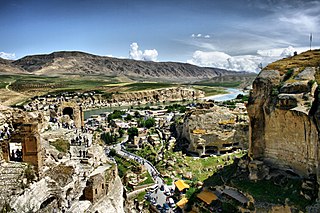
Batman Province is a province in Turkey. It was created in May 1990 with the Law No. 3647 taking some parts from the eastern Province of Siirt and some from the southern Province of Mardin. Its area is 4,477 km2, and its population is 634,491 (2022). Its current governor is Ekrem Canalp.

Photojournalism is journalism that uses images to tell a news story. It usually only refers to still images, but can also refer to video used in broadcast journalism. Photojournalism is distinguished from other close branches of photography by having a rigid ethical framework which demands an honest and impartial approach that tells a story in strictly journalistic terms. Photojournalists contribute to the news media, and help communities connect with one other. They must be well-informed and knowledgeable, and are able to deliver news in a creative manner that is both informative and entertaining.

The Artuqid dynasty was established in 1102 as an Anatolian Beylik (Principality) of the Seljuk Empire. It formed a Turkoman dynasty rooted in the Oghuz Döğer tribe, and followed the Sunni Muslim faith. It ruled in eastern Anatolia, Northern Syria and Northern Iraq in the eleventh through thirteenth centuries. The Artuqid dynasty took its name from its founder, Artuk Bey, who was of the Döger branch of the Oghuz Turks and ruled one of the Turkmen beyliks of the Seljuk Empire. Artuk's sons and descendants ruled the three branches in the region: Sökmen's descendants ruled the region around Hasankeyf between 1102 and 1231; Ilghazi's branch ruled from Mardin and Mayyafariqin between 1106 and 1186 and Aleppo from 1117–1128; and the Harput line starting in 1112 under the Sökmen branch, and was independent between 1185 and 1233.

Mardin Province is a province and metropolitan municipality in Turkey. Its area is 8,780 km2, and its population is 870,374 (2022). The largest city in the province is Kızıltepe, while the capital Mardin is the second largest city.

Mardin is a city and seat of the Artuklu District of Mardin Province in Turkey. It is known for the Artuqid architecture of its old city, and for its strategic location on a rocky hill near the Tigris River.
Kurdish Hezbollah or Hizbullah, is a Kurdish Sunni Islamist militant organization, active against Turkey, and the PKK. It is derogatorily known by its critics as Hizbulkontra, Hizbulvahşet, and Hizbulşeytan. They are also derogatorily known as Sofik, which is a diminutive of "Sofu", which means "devout" or "practicing".

Hasankeyf is a town located along the Tigris, in the Hasankeyf District, Batman Province, Turkey. It was declared a natural conservation area by Turkey in 1981.

Mehmed Uzun was a Kurdish writer and novelist born in Siverek, Şanlıurfa Province, Turkey. Though the Kurdish language was outlawed in Turkey from 1920 to 1990, he started to write in it and achieved much toward shaping a modern Kurdish literary language and reviving the Kurdish tradition of storytelling. In 1977–2005 he lived in exile in Sweden as a political refugee, becoming a prolific writer, author of a dozen Kurdish-language novels and essays, which made him a founding member of Kurdish literature in Kurmanji dialect. In June 2005 he returned to Istanbul. He was a member of the PEN club and the Swedish writers association. On May 29, 2006, he was found to have stomach cancer. After treatment at the Karolinska University Hospital in Stockholm, he returned to Diyarbakir, Turkey, where he died, aged 54.

Turkish Kurdistan or Northern Kurdistan is the southeastern part of Turkey where Kurds form the predominant ethnic group. The Kurdish Institute of Paris estimates that there are 20 million Kurds living in Turkey, the majority of them in the southeast.
The word serhildan describes several Kurdish protests and uprisings since the 1990s that used the slogan "Êdî Bese" ("Enough") against Türkiye. Local shops are often closed on the day of demonstrations as a form of protest.
The Milan is a Kurdish tribe that was historically at the head of a multi-confessional tribal confederacy, and is the subject of one of the legends of origin of Kurds, together with their rivals, the Zilan.
The 2011–2012 Kurdish protests in Turkey were protests in Turkey, led by the Peace and Democracy Party (BDP), against restrictions of Kurdish rights by of the country's Kurdish minority's rights. Although they were the latest in a long series of protest actions by Kurds in Turkey, they were strongly influenced by the concurrent popular protests throughout the Middle East and North Africa, and the Turkish publication Hürriyet Daily News has suggested that the popularly dubbed "Arab Spring" that has seen revolutions in Egypt and Tunisia may lead to a "Kurdish Summer" in the northern reaches of the Middle East. Protesters have taken to the streets both in Istanbul and in southeast Turkey, with some demonstrations also reported as far west in Anatolia as İzmir.
Massacres of Diyarbakır were massacres that took place in the Diyarbekir Vilayet of the Ottoman Empire between the years of 1894 and 1896 by Muslims, a majority of whom were ethnic Kurds. The events were part of the Hamidian massacres and targeted the vilayet's Christian population – mostly Armenians and Assyrians.
Mehmet Sincar was a Kurdish politician from Turkey and a Democracy Party (DEP) member of the Grand National Assembly of Turkey. He was assassinated in September 1993 together with the local chairman of the DEP in Batman. The Turkish Revenge Brigade took responsibility.
Vedat Aydın was a Kurdish politician in Turkey and human rights defender. He was married to Sükran Aydın.
The Republic of Turkey has an official policy in place that denies the existence of the Kurds as a distinct ethnicity. The Kurds, who are a people that speaking various dialects of Northwestern Iranic languages, have historically constituted the demographic majority in southeastern Turkey and their independent national aspirations have stood at the forefront of the long-running Kurdish–Turkish conflict. Insisting that the Kurds, like the Turks, are a Turkic people, Turkish state institutions do not recognize the Kurdish language as a language and also omit the Kurdish ethnonym and the term "Kurdistan" in their discourse. In the 20th century, as the words "Kurd" and "Kurdish" were prohibited by Turkish law, all Kurds were referred to as Mountain Turks in a wider attempt to portray them as a people who lost their Turkic identity over time by intermingling with Arabs, Armenians, and Persians, among others. More recently, Turkey's opposition to Kurdish independence has defined how it has conducted itself throughout the Middle East, particularly with regard to the Autonomous Administration of North and East Syria and the Kurdistan Region of Iraq.
Dicle-Firat was a bilingual newspaper in the languages Turkish and Kurdish and published in Istanbul between September 1962 and May 1963. It focused on the Turkification process of the Kurds and the so-called "Eastern question" while east was used to describe the eastern Kurdish regions in Turkey. It had lectors throughout most provinces and letters to the editorial board were sent in from a variety of cities such as Mardin, Erzurum, Van, Siirt, Igdir, Diyarbakir or Ağrı. Prominent Kurdish journalists like Yasar Kaya, Musa Anter or Edip Karahan, played a significant role in the newspaper. The newspaper also established an office researching the Kurdish heritage in the Kurdish populated region in the east of Turkey. Edip Karahan, the owner of the newspaper and Musa Anter were arrested in June 1963 and the newspaper closed down by the Turkish authorities.
Emirate of Çemişgezek was a hereditary and autonomous Kurdish emirate existing from the 13th century to 1663, centered around Çemişgezek including Mazgirt, Pertek and Sağman. The emirate was populated by both Muslims and non-Muslims, and moreover had a significant Kurdish Alevi population which flourished and expanded due to the secured self-governance under Ottoman rule, despite Ottoman antagonism towards the minority. Beside Kurds, the emirate had a Bozulus population. According to Sharafnama, the 12–13th-century rulers of the emirate were of Turkic origin.

Mezopotamya Agency is a Kurdish news agency based in Beyoğlu, Istanbul. It is described as pro-Kurdish by the Platform to promote the protection of journalism and safety of journalists of the Council of Europe (COE), and left-wing by the International Observatory of Human Rights. It publishes articles in Kurdish, Turkish and English language. Mezopotamya Ajansı's www.mezopotamyaajansi35.com website, which had been blocked 34 times before, was also blocked on the grounds of 'protection of national security and public order' by Erzurum 1st Criminal Judgeship of Peace on March 12. Thereupon, the agency continued to publish on www.mezopotamyaajansi.net

Mem Ararat is a Kurdish singer, songwriter, and composer from Turkey.









